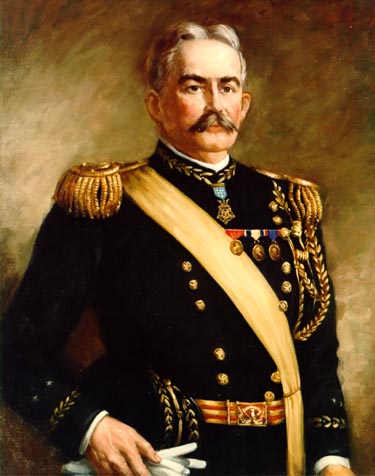
James Franklin Bell was born near Shelbyville, Kentucky, on 9 January 1856; was educated at local schools and graduated from the United States Military Academy, 1878; was commissioned a second lieutenant, 9th Cavalry, June 1878; transferred to the 7th Cavalry at Fort Lincoln, August 1878; married Sarah Buford, 1881; served with the military escort for Northern Pacific Railroad construction crews, 1882; was engaged in troop training and escort duty at Fort Buford, 18821886; was professor of military science and tactics at Southern Illinois University, 18861899; while there studied law and was admitted to the bar; was promoted to first lieutenant, December 1890, and served as adjutant of the 7th Cavalry, 18911894; was concurrently secretary of the Cavalry and Light Artillery School, Fort Riley, 18931894; was aide to the commander of the Department of California, 18941897; was on garrison duty at Fort Apache, 18971898; was appointed judge advocate, Department of the Columbia, 1898; was assigned to General Wesley Merritts Philippines expedition as major of volunteers and engineer officer, May 1898; was appointed chief of military information, Department of the Pacific, and dispatched to Manila to gather information, June 1898; participated in military operations against insurrectionists; was promoted to captain, 7th Cavalry, March 1899, and major of volunteers and assistant adjutant general, April 1899; was acting judge advocate and mustering officer, 2d Division, VIII Corps; was appointed colonel, 36th Volunteer Infantry, July 1899, earning the Medal of Honor for gallantry in action near Proac, Luzon, in September; was appointed brigadier general of volunteers, December 1899; commanded the 4th Brigade, 2d Division, Department of the Pacific, January 1900; was provost marshal of Manila, 19001901; was promoted to brigadier general in the regular establishment, February 1901; commanded the First District, Department of Luzon, 1901, and 3d Brigade in field operations, 19011902; was commandant of the Army Service Schools, Fort Leavenworth, 19021906; was promoted to major general, January 1907; was chief of staff of the United States Army, 14 April 190621 April 1910; prepared and secured progressive passage of elements of a long-range legislative program calling for increases in strength, pay, technical services, and reserve forces; installed and commanded the Army of Cuban Pacification; presided over the development of Army aviation and relief efforts in the San Francisco earthquake; commanded the Department of the Philippines, 19111914, the 2d Division (Tactical), 19141915, the Western Department, 19151917, and the Eastern Department, 1917; commanded Camp Upton and the 77th Division and visited the theater of war in France, 19171918; resumed command of the Eastern Department, 19181919; died in New York City on 8 January 1919.
The Artist
Adrian Lamb (1901) was born in New York City, where in the mid-1920s he studied at the Art Students League under Frank Vincent DuMond and George Bridgman. After attending the Académie Julien in Paris in 1929, he went on to travel and work in England, France, Spain, Germany, Italy, Greece, and Mexico as he developed his talent as a portrait painter. Mr. Lamb lives in Connecticut and maintains a studio in New York City. Among his many prominent subjects have been David Rockefeller, John J. McCloy, Joseph P. Kennedy, and Bernard Baruch. He executed the Gordon Gray portrait in the Army Secretarial Portrait Gallery, and his paintings of other public figures hang in the United States Capitol, the Supreme Court, the State Department, and the National Gallery of Art.
James Franklin Bell
By Adrian Lamb
Oil on canvas, 36½" x 30", 1973
[98]

page updated 30 April 2001